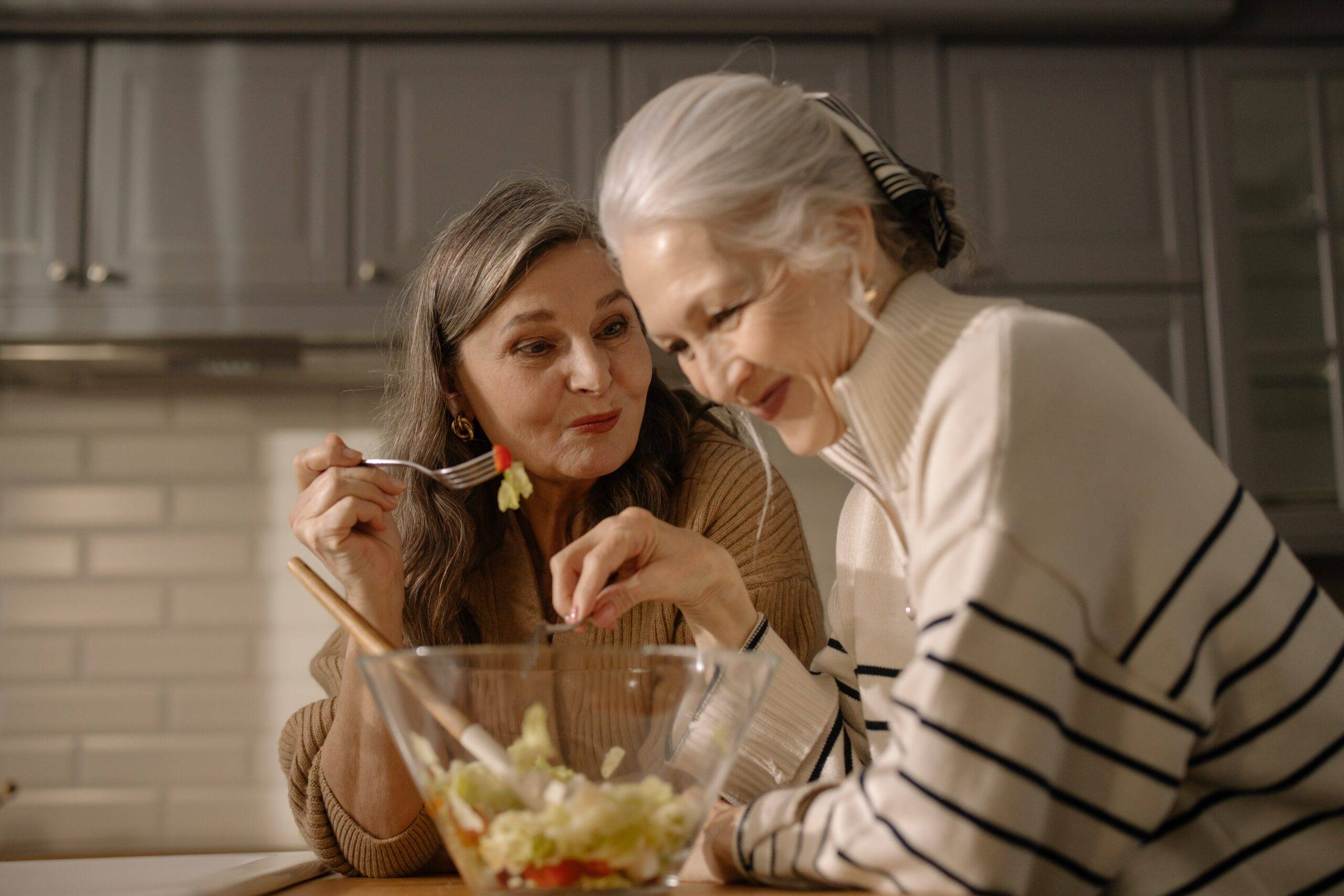As a caregiver, you play an important role in keeping your loved one healthy. Good nutrition is essential for seniors, as it helps to protect against many chronic diseases. It can also boost their energy levels and mood. But it can also be a challenge to navigate their specific needs, such as allergies and intolerances. Further complicating mealtime, some ailments (such as dementia) may cause erratic behavior in your loved one (behavior that often seems to peak at mealtime). If your loved one is struggling to eat a nutritious diet, there are several things you can do to help. In this article, we’ll explain the importance of nutrition and how to create enjoyable and balanced meal time experiences with the loved one in your care. Let’s dive in.
Why Nutrition Matters for Aging and Ailing Adults
As we age, our bodies become less efficient at absorbing nutrients from food. At the same time, aging adults may be less active or have a reduced appetite. As a result, older adults are at risk of becoming undernourished or malnourished.
A lack of nutrition can lead to a weakened immune system, increased susceptibility to illness, increased hospital visits, and a slower recovery from injuries. (Source) In addition, poor nutrition can contribute to cognitive decline and reduce the quality of life in older age. For these reasons, it is essential that aging and ailing adults receive proper nutrition. A healthy diet can help to maintain strength and vitality, improve cognitive function, and promote overall well-being. By ensuring that the aging or ailing adult(s) in your care get the nutrients they need, you can help them to stay healthy and independent for longer.
Challenges Caregivers Face at Mealtime
Caregivers often face challenges when it comes to preparing meals for aging and ailing adults. Poor appetite, difficulty swallowing, dental problems, and more can make it hard to get them to eat enough of the right foods. As a result, caregivers may need to get creative when it comes to planning meals.
You may need to puree or chop foods, sneak in extra calories and nutrients, or find ways to make meals more appealing. Additionally, you may need to be patient when it comes to mealtime, as older adults may take longer to eat. But with a little planning and creativity, caregivers can help ensure that their loved ones are getting the nourishment they need.
5 Tips for Creating Enjoyable and Nutritious Mealtime Experiences
As people age, they often become less interested in food and may start to lose weight. This can be a problem for caregivers, who need to make sure their charges are eating enough to stay healthy. There are a few things that caregivers can do to encourage their aging or ailing charges to eat more nutritiously:
1. Make sure that the foods available are healthy and appealing.
If the pantry is full of unhealthy junk food and the freezer is full of easy microwaveable meals, it will be difficult to get the person to eat more nutritiously. Instead, stock up on healthy snacks and meals that the person will enjoy eating. Additionally, make sure to offer a variety of foods at each meal, including at least one source of lean protein, whole grains, and fruits or vegetables.
Bonus tip: You can also add/hide nutrient-rich ingredients to recipes. For example, try blending carrots or zucchini into your pasta sauce before you add it to the pasta, or blend flax seeds, oats, cooked brown rice, or nuts into a smoothie or milkshake.
2. Encourage small meals throughout the day.
Older adults often have trouble digesting large meals, so it’s sometimes better to encourage them to eat smaller meals more often. This will help them get the nutrients they need without feeling overloaded at any one time.
3. Offer liquid supplements.
If the person is having trouble eating solid food, offer them liquid supplements such as shakes or soups. These can be packed with nutrients and are often easier for older adults to digest. Liquid meals also contain more water, which can help them maintain hydration.
4. Make it appealing.
Try to make meals more appealing and enjoyable by serving favorite foods and using attractive plates and silverware. We all enjoy our food just a little bit more when it looks nice, so taking time to make the meal itself or the dishware it’s served on a bit more appealing can go a long way.
5. Cook together.
By preparing meals together, caregivers and the loved one in their care have an opportunity to discuss healthy food choices and get creative in the kitchen. You can bulk-cook a few meals that can be enjoyed all week. Cooking together gives caregivers a chance to discuss the food and make sure they’re cooking something their loved one will enjoy that it isn’t simply a freezer/microwaveable meal (a go-to for aging and ailing adults that don’t have the energy to cook when they’re alone). For example, caregivers can demonstrate how to portion out servings or incorporate more fruits and vegetables into meals.
Closing Thoughts
Mealtime can feel like a chore for many caregivers. Balancing the challenges of nutrition, enjoyable mealtimes, sensitive stomachs, and more can be overwhelming. We hope you found a tip or two to make mealtime a little smoother for you. By following these simple tips, you can help your loved one enjoy a healthy and nutritious diet.
Further Reading: Getting Paid to Provide Care for a Loved One
If you are a caregiver, we recommend you check out our article about getting paid to be a caregiver in California next. Becoming a caregiver is both physically and mentally difficult, and expensive. The state of California offers several paths for least partial compensation or subsidized assistance, so click here to learn more about how to get paid to be a caregiver.
Share this post: